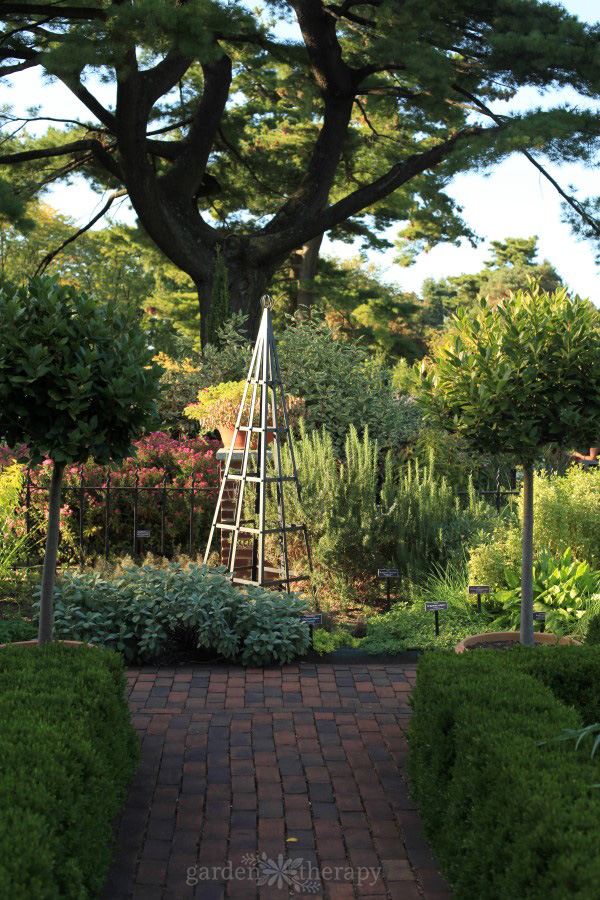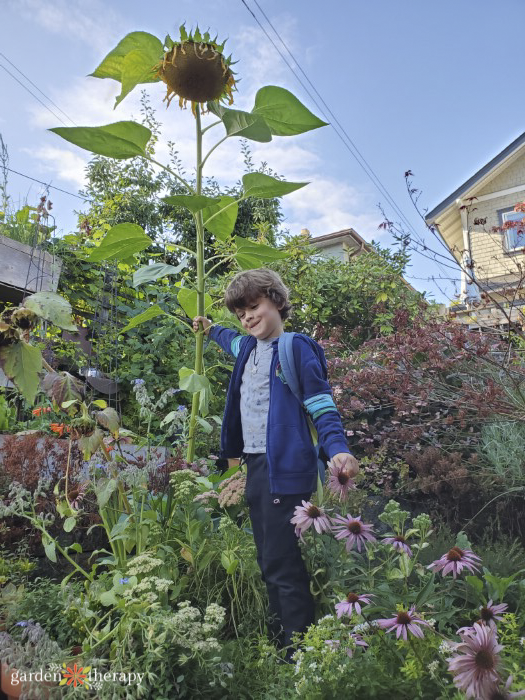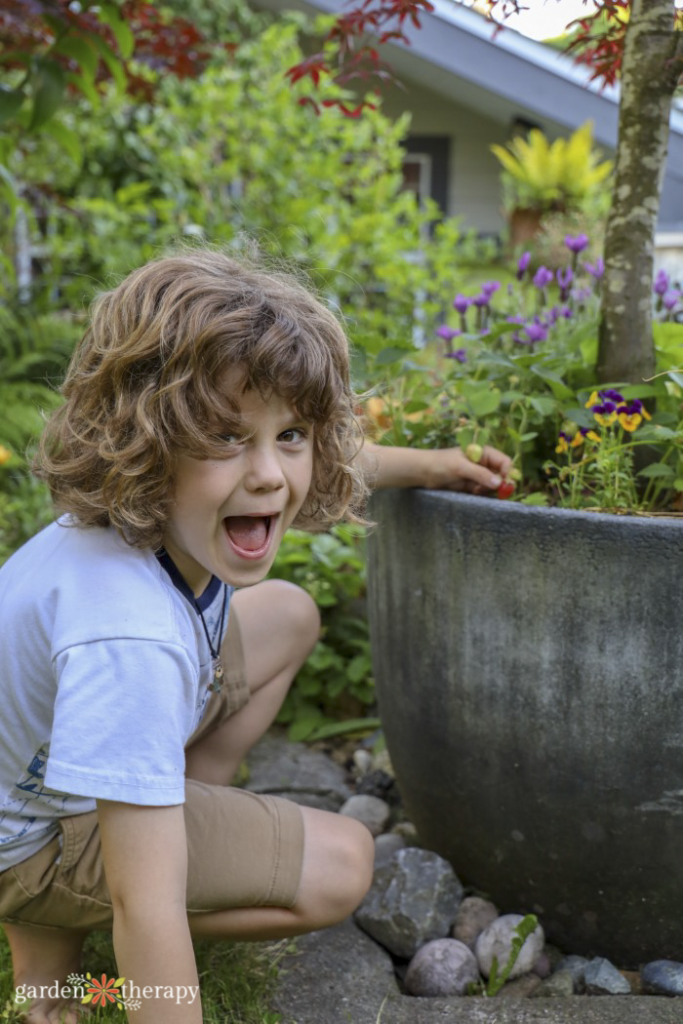Plant Blindness: The Silent Epidemic Sabotaging Our Well-Being and Earth’s Future
Nature deficit disorder shows how much our mood and behaviour can change when we live a life separated from nature and plants. This plant blindness is quickly becoming a growing problem—for our mental health and the environment. Here’s what you need to know.

A little while ago, I did a talk with Growing Joy With Maria, and she talked about how growing houseplants helped her to turn her depression around—something I can very much relate to here on Garden Therapy.
She mentioned something that really stuck with me: plant blindness. Before, she never really considered plants useful or worthwhile, but once she committed to growing houseplants, she noticed an immediate change.
I myself didn’t grow up as a gardener, discovering plants as an adult when I turned to gardening as a way to get outside and move my body while suffering from a new disability.
I heavily experienced plant blindness and nature deficit disorder when I was younger, and I think that many people today do. Finding these pockets of nature and peace in our cities is extremely hard.
Today, I want to bring to light just how bad plant blindness can be and that it’s essential we ensure our future generations have access to plants.


What is Plant Blindness?
Ask someone to name the tree that stands in front of their house, the shrub on the side of the path, or the flowers in their vase at home, and there’s a good chance they’ll struggle.
Plant blindness is when you lack awareness and appreciation for plants. And it’s on the rise, especially for those of us who grow up in urban environments.
When I was growing up, I didn’t notice plants much. I never grew up as a gardener since I didn’t have plant-obsessed parents or tons of nature around me to teach me a love for it.
I could walk by trees and not really notice them. My eyes were on the uninteresting sidewalk in front of me.
For me, this changed when I became disabled. Suddenly, I was forced to find new outlets, and gardening became a way of healing for me—for which I am eternally grateful.
Our minds are overloaded with information every day. They constantly need to sift through new information and decide what knowledge to retain.
Unfortunately, our society doesn’t prioritize this plant knowledge. So in turn, our brains don’t deem it as important. Most of nature becomes one big green blur to a majority of people.
In a study out of the UK, 82% of children couldn’t identify an oak leak. Another study found that out of all its A-level biology students, only 14% of them could identify more than three native plant species. And the same was said of their teachers, too!


What is Nature Deficit Disorder?
I’ve talked plenty about the benefits of being out in nature, from reducing stress and anxiety to actually helping reduce depression symptoms. Many people feel it the second they step out into green space just how much it can refresh and change their mood.
Nature Deficit Disorder is the exact opposite of that. A term coined by Richard Louv in his book, Last Child in the Woods: Saving Our Children from Nature-Deficit Disorder, it is a non-medical term used to describe how the lack of nature can affect a child’s behaviour.
Children who have access to nature are less aggressive, more focused, have greater self-awareness, and have stronger immune systems.
When we all were cooped up indoors in 2020, this became extremely evident. We were all itching to go outside, and those who didn’t have direct access to safe greenspaces (i.e. their own backyard) quickly began to struggle.
A lack of greenspaces affects those in lower socio-economic classes way more, and in turn, minorities as well. I see it myself in Vancouver, as the areas with larger homes have more green space and large street trees, while areas with higher-density apartments have significantly less greenery around them.


Effects of Plant Blindness and Nature Deficit Disorder
Beyond how it affects our mental health, plant blindness has a larger effect on the world. Just like animals, there are many plants on the endangered species list, and a whopping 40% of all flora are at risk of extinction.
Most of us don’t think about saving these plants the same way that we think about saving the animals. In 2020, the US spent roughly $1.2 billion on helping endangered species, and 67% of that went to the recovery of two fish: salmon and steelhead trout. Just 2% of all the funding went to helping plants.
Plants have significant value, but many of us aren’t seeing it. A very limited amount is used to feed us in the grocery store despite many being edible.
But plants have so many uses, such as revitalizing soil, feeding wildlife, providing medicine, being used as construction tools, and having significant cultural value.
All of this stems from our loss of connection to plants. Without this connection, people don’t see the value in plants and nature and, therefore, don’t prioritize them.
Preventing Nature Deficit Disorder
A few years ago, I worked at the UBC farms as a Master Gardener in their Intergenerational Landed and Learning Program. In this program, they would bring inner-city schoolkids to the farm every second week, and we would work with them over the school year.
In the program, we would take them through a plant’s whole cycle to help them understand how plants grow, what it takes to grow food, and how to prepare and cook this homegrown food.
The program began in September, so it would begin with a great harvest left behind from the previous group. This also taught them the importance of providing food for the next generation.
In the very first session, a group facilitator would ask the kids what their favourite vegetable was. The kids would yell out “pizza!” or “French fries”, and I was quite amazed that many didn’t really understand what a vegetable was.
But by the end of the year, they would be holding their tummies saying they hurt because they ate too much of the kale flowers. What a difference!
Falling in love with plants is vital to stopping plant blindness and nature deficit disorder, but not everyone has the privilege of doing so. There are many urban deserts out there that make it difficult to see and interact with plants.
The big houseplant boom certainly has to do with that, as it’s the easiest way to interact with greenery.
Many gardeners have fallen in love with plants, and we feel a special connection to the earth and to fellow plant lovers. It’s up to us to try and encourage others.
People love learning about their food, so that’s a great place to start. Just think about how many of us start gardening by growing our own food.
We need to train our brains that plants are important by interacting with them frequently and in a way that directly relates to ourselves. Plants need to hold a place of value.
One of the most important things we can do is teach the next generation that plants are powerful, useful, and important.


Tips for Staying Connected to Nature







